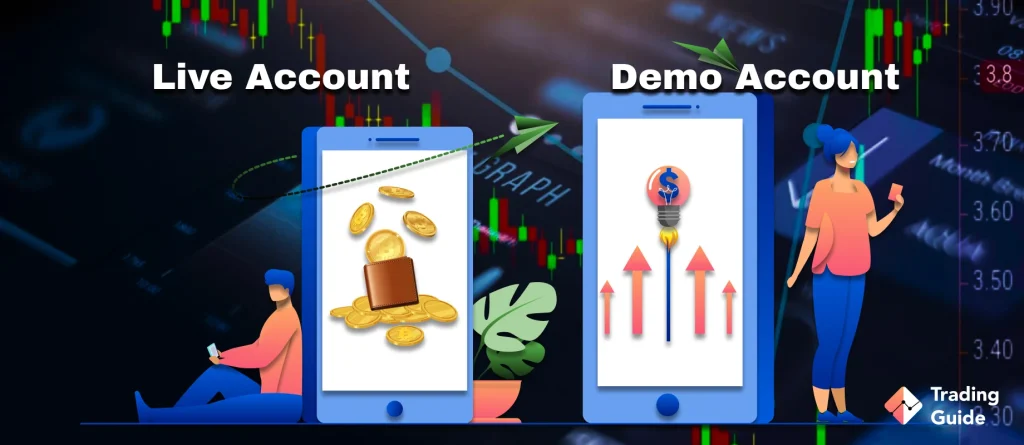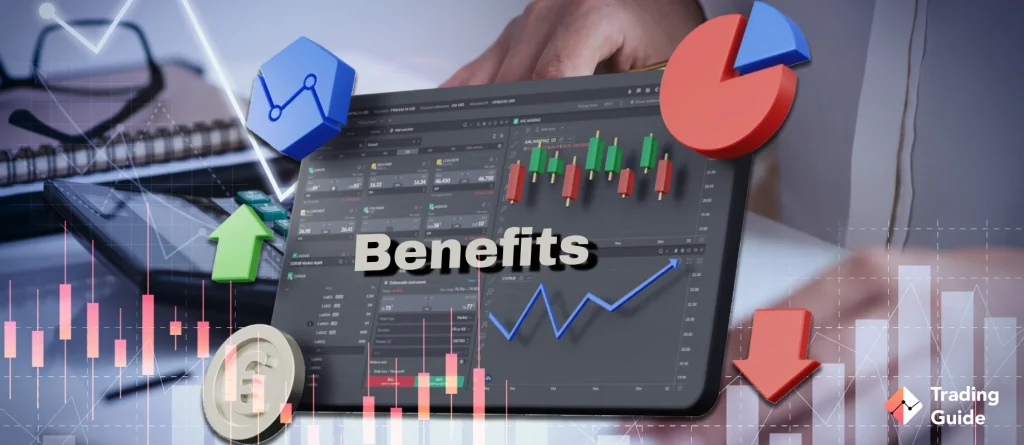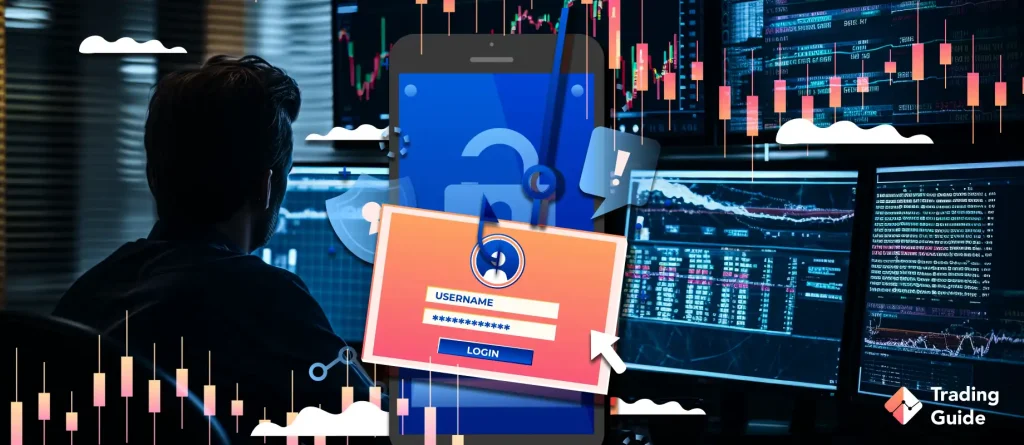Our ultimate guide is meant to give you more insight into the difference between demo and live trading accounts. So, if you are a beginner at trading, this guide will help you get off to a good start.
In this modern technological era, finding a broker with a simple yet efficient trading account is a need for every trader. Note that there are a gazillion trading brokers offering different types of trading accounts. Therefore, as a trader, you must consider an account that is not only user-friendly but also easy to understand. The account should also offer as many tradable instruments that best suit your trading style.
Beginners should not rush into trading using live accounts since most brokers offer demo accounts to experiment with. Let’s dive deeper into what differentiates a demo account from a live trading account.
Difference Between Demo Account and Live Account

After conducting your research on a broker and confirming that what they are offering compliments your trading needs, you may want to test them out before investing your hard-earned cash.
Demo accounts are meant for this purpose because they are free of charge. This means that you do not need to invest your money trading using demo accounts because the brokers already support you with free virtual funds. There are also no real profits with demo accounts.
For example, eToro’s demo account is backed up with $100,000 virtual funds, which is more than enough to help you manoeuvre the platform and familiarise yourself with how it works. Simply put, the primary purpose of demo accounts is to prove that a broker is worth trading with.
In contrast, live trading accounts allow you to invest your actual funds. The environment on this trading account is slightly different from the demos because any wrong move will cost you your hard-earned cash. However, if a trade favours your strategy, you will be smiling on your way to the bank.
We usually advise our readers, especially novice traders, to start trading using demo accounts. This is because you won’t be blindly risking your money, and it’s also an excellent platform to learn how a broker works before setting off your trading venture using real money.
Execution Differences
Although demo and live trading accounts are similar in many ways, there are a few ways in which they differ. Let’s take a look at their differences when it comes to trade execution.
- Demo accounts mostly do not have re-quotes since trading using them won’t let you into the real financial markets. Re-quotes occur when the markets are fast-paced, and your trade cannot be executed at a specified price. In this setting, your broker will requote your order and allow you to confirm afterwards. This is only experienced when you trade on a live account.
- Like re-quotes, there is also no slippage when you trade using demo accounts. Slippage is the difference between the expected price and the execution price of a trade. Slippage mainly occurs in the financial markets, and when they do, your trades will be executed at a less favourable price.
- There is a difference in price feed when it comes to demo and live trading accounts. Other than bid and ask prices, the spreads in these accounts also differ. They are always fixed in a demo account and fluctuate when you trade on a live account based on the traders’ interaction.
- Stop-loss order execution is different in demo accounts compared to live accounts. It’s easy to manage stop-loss orders on demo accounts since there is no access to the real live markets compared to live accounts, where stop-loss orders may be executed at higher levels, enhancing the trading risks.
- Market liquidity also varies in demo and live trading accounts since liquidity depends on the current market conditions. It’s challenging to estimate a moving market on a demo account compared to a live account, affecting spread, latency time, and slippage.
Psychological Difference
There are also psychological differences between trading on demo and live accounts. You see, when you trade on demo accounts, you have nothing to lose since you get to trade using virtual funds. There is no trading capital involved, which puts you in a comfortable situation.
In contrast, live accounts trigger various emotions, such as fear of losing your money or greed to earn more profits. Therefore, the attention you will pay to your trades on demo accounts will differ from that in a live trading account. That is why you will see many traders succeed on demos but lose money the moment they shift to live trading accounts.
Demo accounts are a risk-free environment, meaning that trading on them does not have real consequences compared to live accounts. Since a trader will not be trading with their real money on demo accounts, it makes them reluctant and reckless in making the right decisions.
Our advice to newbies is that they do not take too long trading using demos. While they are a platform to familiarise yourself with how a broker works, overtrading can also have a negative impact on your trading decisions in the long run.
Benefits of Demo Accounts

As mentioned earlier, demo accounts are good platforms to start trading with, especially if you have no idea how a broker works. They work like a safe haven to test a broker without risking your hard-earned cash.
As a beginner, there are many trading techniques to learn, and since demo accounts are free for usage, they are the best platforms to practice trading while learning various strategies using the available educational tools provided by a broker.
You can also try to understand the order types, which will significantly help manage trading risks when you start investing using a live account. After all, the primary goal of trading using live accounts is to make profits, so the earlier you take precautions, the better for you in the long run.
How to Open a Demo Account

After conducting your thorough research on a broker or choosing our recommended ones, you may need to try the broker’s trading platform. For this to happen, the broker will require you to create a demo account. Take a look at the three steps to follow:
- The first step to creating a demo account is to register with your broker of choice. Usually, brokers require your basic personal information such as name, phone number, email, address, identification number, password and more. Note that you must also be of the required minimum age to qualify, mostly 18 years.
- Identify your account type since there are various types of accounts offered by brokers. For example, it can be the standard proprietary account, cTrader account, MetaTrader account, ECN account, and more.
Also, you can choose your broker by your account type priority: cTrader brokers, MetaTrader brokers, ECN brokers, NDD brokers and more. - You will then have access to virtual funds that you should use to experiment with the broker. Note that some brokers have a days limit for using their demo accounts. For example, Pepperstone offers traders $50,000 virtual funds to trade within 30 days.
How to Open a Live Account
Opening a live trading account is slightly different from creating a demo account. Below are the steps to follow for most brokers.
- Register using your personal details and secure password.
- Some brokers will require you to take a suitability test to confirm your suitability in trading various financial assets such as derivatives. The test contains a simple questionnaire, which you get the results instantly.
- Verify your Identification. For security reasons, a broker will require proof of identity, including copies of identity documents such as ID card, passport, or birth certificate. They will also need documents that prove your physical address, such as a bank statement or utility bill not older than 3 months.
- After your identity has been verified, you can proceed to fund your account and start trading. Note that there are various minimum deposit requirements on different brokers. Therefore, make sure the amount fits into your budget before settling for a broker.
Note: Some brokers do not have demo accounts, such as Revolut. This does not mean that you shouldn’t give them a try since most brokers charge a small amount of trading costs. The best thing about them is that you get to test a broker in a live trading environment, which keeps you on your toes compared to using demo accounts.
Conclusion
Demo accounts are not only meant for newbies, but experienced traders can also benefit from them, especially when trying out new trading strategies. Some brokers have micro trading accounts, which requires small amounts to trade with. They have also proven to be beneficial since traders get the complete feel of a live trading account before diving in.
As a new trader with minimal trading experience, a demo account is a perfect platform to get started. With no risks involved, including emotional commitment, you can fully focus on learning how a broker works. You can then proceed to micro-accounts once you gain a little confidence in your strategy. Also, consider the distinctions between Cent and Micro accounts when choosing the most suitable account type.
Remember, becoming an experienced trader takes time, and you must be patient and ready to learn if you intend to succeed in this industry. Also, the broker you trade with contributes a great deal to your success. Therefore, make sure that you consider one with requirements that complements your trading needs.




Which Forex brokers would you recommend to start a free demo account on? Do brokers charge commission fees on demo accounts?
Forex.com
According to my experience, the best way to know is to try it yourself. At least that’s what I do. When I look for a broker, I just go to their platform and check out their services and website. Then I gather information about it, read reviews and if it suits me, I start a demo. That’s one way of knowing a broker. I remember opening a demo with IG and even Turnkey Forex. Later I shifted to the live account since the conditions were pretty suitable for me. Also, Avatrade has some acceptable trading conditions and services, you can try their demo to find it out yourself.